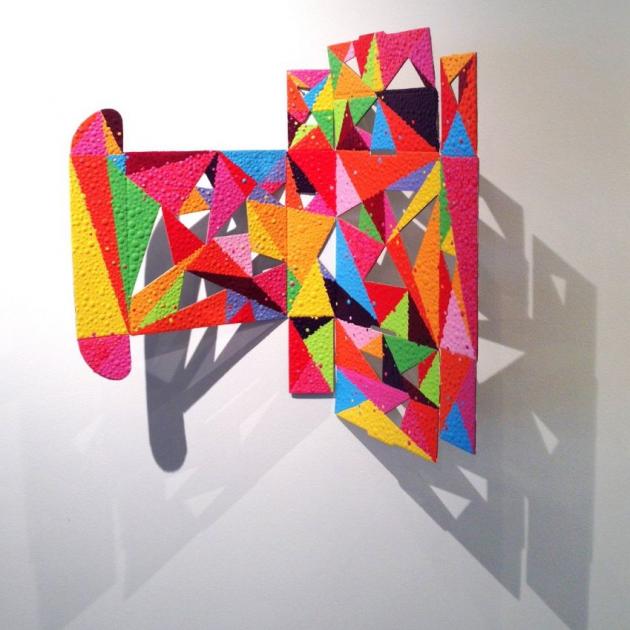
''6x2'', group show (Gallery Thirty Three, Wanaka)
Gallery Thirty Three's ''6x2'' is basically the artistic equivalent of a sampler box of chocolates, with six artists each contributing two works representative of their current style.
The title is not entirely accurate, as several artists are working in collaboration and a few extra pieces have slipped into the mix, but standards are so high that the deviation from the theme is a blessing.
Louise Greig includes two portraits of young women in varying states of emotion: The Lamentation and Eulalia.
The first, as the title would suggest, is a depiction of heartbroken melancholy, but there is a dignified restraint to the image that suggests the subject will not break down, despite her shed tears.
Eulalia is more guarded and wary, suspicious of the viewer.
Nicky Foreman's Encompass I and II are circular works, jewel-toned and metallic, and slightly archaic in appearance.
They might be museum pieces, the most gorgeously painted shields for a gladiator.
Philip Jarvis' sculptures are oversized origami, and they're staggeringly beautiful.
The milk bottle and coat hanger Magnolia flowers defy the solidity of their construction to appear like delicate wisps of tissue paper, while the Painted Boxes employ a striking shadow effect and appear to be playfully awaiting assembly.
Other excellent works include the pure, sinuous elegance of Kiya Nancarrow's sculpture, the cool-toned serenity of Simon Kaan's woodcut series, and the intricate detail of Michel Tuffery and Flox's embossed prints.

''No Animals Were Harmed'', Lizzie Carruthers (Studio Red, Bannockburn)
Artist and working farmer Lizzie Carruthers translates her experience of rural life into her work, focusing on her interaction with animals as both livestock and family pets.
''No Animals Were Harmed'' presents a large number of oil paintings, all of them small in scale, but intensely coloured and bursting with personality.
Mounted closely together, the collective effect is of being surrounded by a menagerie of curious faces and vibrant energy.
Each painted animal is as individual as would be a living counterpart, and emotions run the gamut from the joyful, tongue-flapping exuberance of the farm dog in Speedster to the grumpy belligerence of Chicken (actually a stroppy-looking cow).
Half the fun of Carruthers' work is guessing which title goes with which piece, and usually laughing when the pun becomes apparent.
The earlier works are slightly more stylised and restrained, with a smoother paint application and finish.
In these, Carruthers brings her animals from the farmyard to the drawing room: the animals tend to have quirky little touches of humanity, such as the bowler hat-clad duck in Tall, Duck & Handsome #3 and the pince-nez-wearing dog in Day at the Track.
The more recent pieces are very much the animals in their natural environment, and the style is more free and spontaneous in appearance.
Carruthers is particularly notable for an unexpected colour range, such as streaks of blue and green in fleece and hair, that works to astonishingly realistic effect.

''Casting Shadows'', Andi Regan (Hullabaloo Art Space, Cromwell)
Wanaka-based artist Andi Regan brings the simple cable-tie from the aisle of the hardware store to the walls of the art gallery.
Her creations can use literally thousands of cable-ties, often coloured in graduating shades to add depth and texture.
The artist's very mechanical and tidy mind is evident in a repetition of pattern and uniformity of shape.
However, the element of fun and play in Regan's work is as obvious as the meticulous cleverness that goes into each piece.
As seen in her current exhibition, Regan's most fascinating collections involve her interpretations of the natural world, combining mother nature's subjects with a distinctly man-made and industrial medium.''
Casting Shadows'' is an exploration into the cocoon and flight patterns of the moth, and a subject that might not traditionally be considered beautiful becomes something rather spectacular.
Dozens of deceptively delicate cable-tie ''moths'' are attached to the gallery walls, looking as fluttery and ethereal as if they have just alighted and could take flight at any moment.
The insects crafted in umbre shades of green are effective, but it is the white moths that are most eye-catching. Ironically so, as they almost disappear against the stark gallery wall.
Light and shadow are used with striking results, and the blurred outlines give an almost ghostly impression of movement.
The spiky hanging cocoons are both gorgeously made and visually disturbing, floating down like creatures from the deep sea or science fiction.
- by Laura Elliot












